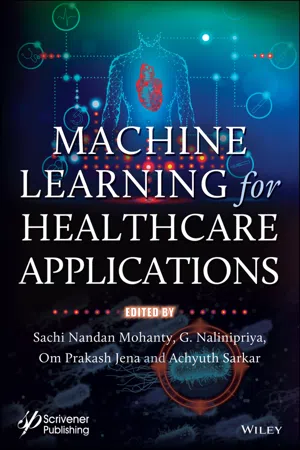
Machine Learning for Healthcare Applications
Sachi Nandan Mohanty, G. Nalinipriya, Om Prakash Jena, Achyuth Sarkar, Sachi Nandan Mohanty, G. Nalinipriya, Om Prakash Jena, Achyuth Sarkar
- English
- ePUB (mobile friendly)
- Available on iOS & Android
Machine Learning for Healthcare Applications
Sachi Nandan Mohanty, G. Nalinipriya, Om Prakash Jena, Achyuth Sarkar, Sachi Nandan Mohanty, G. Nalinipriya, Om Prakash Jena, Achyuth Sarkar
About This Book
When considering the idea of using machine learning in healthcare, it is a Herculean task to present the entire gamut of information in the field of intelligent systems. It is, therefore the objective of this book to keep the presentation narrow and intensive. This approach is distinct from others in that it presents detailed computer simulations for all models presented with explanations of the program code. It includes unique and distinctive chapters on disease diagnosis, telemedicine, medical imaging, smart health monitoring, social media healthcare, and machine learning for COVID-19. These chapters help develop a clear understanding of the working of an algorithm while strengthening logical thinking. In this environment, answering a single question may require accessing several data sources and calling on sophisticated analysis tools. While data integration is a dynamic research area in the database community, the specific needs of research have led to the development of numerous middleware systems that provide seamless data access in a result-driven environment.
Since this book is intended to be useful to a wide audience, students, researchers and scientists from both academia and industry may all benefit from this material. It contains a comprehensive description of issues for healthcare data management and an overview of existing systems, making it appropriate for introductory and instructional purposes. Prerequisites are minimal; the readers are expected to have basic knowledge of machine learning.
This book is divided into 22 real-time innovative chapters which provide a variety of application examples in different domains. These chapters illustrate why traditional approaches often fail to meet customers' needs. The presented approaches provide a comprehensive overview of current technology. Each of these chapters, which are written by the main inventors of the presented systems, specifies requirements and provides a description of both the chosen approach and its implementation. Because of the self-contained nature of these chapters, they may be read in any order. Each of the chapters use various technical terms which involve expertise in machine learning and computer science.
Frequently asked questions
Information
Part 1
INTRODUCTION TO INTELLIGENT HEALTHCARE SYSTEMS
1
Innovation on Machine Learning in Healthcare Services—An Introduction
AbstractThe healthcare offerings in evolved and developing international locations are seriously important. The use of machine gaining knowledge of strategies in healthcare enterprise has a crucial significance and increases swiftly. In the beyond few years, there has been widespread traits in how system gaining knowledge of can be utilized in diverse industries and research. The organizations in healthcare quarter need to take benefit of the system studying techniques to gain valuable statistics that could later be used to diagnose illnesses at a great deal in advance ranges. There are multiple and endless Machine learning application in healthcare industry. Some of the most common applications are cited in this section. Machine learning helps streamlining the administrative processes in the hospitals. It also helps mapping and treating the infectious diseases for the personalised medical treatment. Machine learning will affect physician and hospitals by playing a very dominant role in the clinical decision support. For example, it will help earlier identification of the diseases and customise treatment plan that will ensure an optimal outcome. Machine learning can be used to educate patients on several potential disease and their outcomes with different treatment option. As a result it can improve the efficiency hospital and health systems by reducing the cost of the healthcare. Machine learning in healthcare can be used to enhance health information management and the exchange of the health information with the aim of improving and thus, modernising the workflows, facilitating access to clinical data and improving the accuracy of the health information. Above all it brings efficiency and transparency to information process.Keywords: Machine learning, healthcare, EHR, RCT, big data